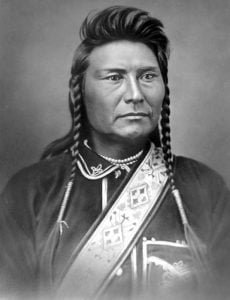Biography of Chief Joseph – Nez Percé
Chief Joseph. Hinmaton-yalatkit. The leader of the Nez Percé in the hostilities of 1877. His mother was a Nez Percé, his father a Cayuse, who received the name Joseph from his teacher, the missionary Spalding, who was with Dr. A. Whitman and who went to the Idaho country in the late thirties of the 19th century. Chief Joseph’s native name was Hinmaton-yalatkit (Hinmaton, `thunder’; yalatkit, ‘coming from the water up over the land.’ – Miss McBeth), but both he and his brother Ollicot were often called Joseph, as if it were a family name. Joseph was a man of fine presence and impressive features, and was one of the most remarkable Indians within the borders of the Union.

